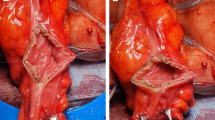Abstract.
Introduction: Early functional outcome after ultra-low anterior resection with coloanal anastomosis (CAA) may be improved by construction of a colonic pouch. The aim of this prospective observational study was to compare results of colonic pouch-anal anastomosis (CPAA) with conventional CAA including the learning curve. Methods: From February 1996 through May 1998, 45 consecutive patients underwent CAA or CPAA following radical rectal resection for cancer. The technique of resection was identical in both groups, and all patients received a diverting stoma. The colonic pouch was constructed using linear staplers. Three and 12 months following stoma closure subjective continence and bowel habits were assessed; anal manometry was performed at 3 months. Results: 20 patients with CPAA (9 F, 11 M, age 62 ± 9 years) were compared to 25 CAA patients (11 f, 14 m, age 64 ± 10 years). There was no mortality, and morbidity was comparable between groups. Three months following stoma closure, in the CPAA group bowel frequency was significantly diminished (1.4 vs 5.8; P < 0.0001), fewer patients had liquid motions (0/20 vs 12/25 patients; P < 0.0001), and more were continent (20/20 vs 4/25; P < 0.001) and able to defer defaecation (20/20 vs 2/25; P < 0.0001). Functional anal canal length was significantly shorter in CPAA patients (2.9 vs 3.5 cm; P < 0.008). Although at 12 months follow-up continence had improved in patients with CAA, bowel frequency (2.5 vs 1.3; P < 0.002), and number of patients with liquid motions (10/25 vs 0/20; P < 0.007) and passive incontinence (12/25 vs 0/20; P < 0.0001) were still significantly higher than the CPAA group. Conclusion: Even including the learning curve, CPAA may yield superior functional results at 3 months and 1 year compared to conventional CAA without increasing morbidity.
Zusammenfassung.
Einleitung: Eine Möglichkeit zur Verbesserung der Frühfunktion nach coloanaler Anastomose (CAA) ist in der Verwendung eines Colonpouchs zu sehen. Ziel dieser Untersuchung war es, im Rahmen einer prospektiven Beobachtungsstudie die Ergebnisse nach Colonpouchrekonstruktion (CPAA) im Vergleich zur konventionellen CAA unter Inklusion der Lernkurve darzustellen. Methoden: 45 konsekutive Patienten wurden untersucht, die im 3-Jahreszeitraum 1996–1998 wegen eines Rectumcarcinoms einer CAA oder CPAA nach radikaler Rectumresektion unterzogen wurden. Die Resektionstechnik war in beiden Gruppen gleich. Bei allen Patienten wurde ein protektives Stoma angelegt. Der Colonpouch wurde mit einem linearen Stapler konstruiert. Drei und 12 Monate nach Verschluß des protektiven Stomas wurde die subjektive Kontinenz, durchschnittliche tägliche Stuhlfrequenz und analmanometrische Daten erhoben. Ergebnisse: 20 Patienten mit CPAA (9 w, 11 m, Alter 62 ± 9 Jahre) wurden mit 25 Patienten mit CAA (11 w, 14 m, Alter 64 ± 10 Jahre) verglichen. Kein Patient verstarb postoperativ und die Morbidität war in beiden Gruppen vergleichbar. Nach 3 Monaten war die tägliche Stuhlfrequenz in der CPAA-Gruppe signifikant geringer (1,4 vs. 5,8; p < 0,0001), weniger Patienten hatten flüssig-breiige Stühle (0/20 vs. 12/25; p < 0,0001), mehr konnten den Stuhl zurückhalten (20/20 vs. 4/25 Pat.; p < 0,001) und auch zeitlich verschieben (20/20 vs. 2/25 Pat.; p < 0,0001). Die funktionelle Analkanallänge war in der CPAA-Gruppe signifikant kürzer (2,9 vs. 3,5; p < 0,008). Nach 12 Monaten besserte sich zwar die Kontinenzfunktion in der CAA-Gruppe, trotzdem waren die tägliche Stuhlfrequenz (2,5 vs. 1,3; p < 0,002), die Anzahl der Patienten mit breiigem Stuhl (10/25 vs. 0/20 Pat.; p < 0,007), und solchen mit passiver Inkontinenz (12/25 vs. 0/20 Pat.; p < 0,0001) immer noch signifikant höher als in der CPAA-Gruppe. Schlußfolgerungen: Auch bei Inklusion der Lernkurve kann durch die Konstruktion eines Colonpouchs das funktionelle Ergebnis im Vergleich zur geraden coloanalen Anastomose nach 3 Monaten und auch nach einem Jahr signifikant verbessert werden, ohne daß eine erhöhte Morbidität dafür in Kauf genommen werden muß.
Similar content being viewed by others
Author information
Authors and Affiliations
Rights and permissions
About this article
Cite this article
Götzinger, P., Wamser, P. & Herbst, F. Coloanale Anastomose: Verbesserung der funktionellen Frühergebnisse durch Rekonstruktion mit Colonpouch. Chirurg 72, 49–53 (2001). https://doi.org/10.1007/s001040051267
Issue Date:
DOI: https://doi.org/10.1007/s001040051267




